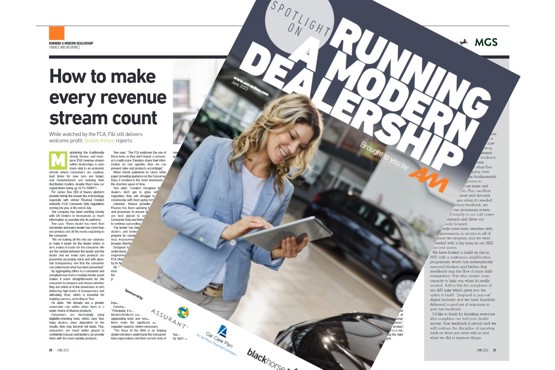Maintaining the traditionally strong finance and insurance (F&I) revenue stream within dealerships is even more vital in an economic climate where consumers are cautious, lead times for new cars are longer, and manufacturers are evolving their distribution models, despite May’s new car registrations being up 16.7% (SMMT).
For James Tew, CEO of finance platform provider iVendi, the answer lies in technology, especially with stricter Financial Conduct Authority (FCA) Consumer Duty regulations coming into play at the end of July. The company has been working closely with UK lenders to incorporate as much information as possible into its platform.
Tew says: “Every dealer has more than one lender and every lender has more than one product and all this needs explaining to the consumer.
“We are baking all this into our solutions to make it easier for the dealer which, in turn, makes it easier for the consumer. We are the conduit between the lender and the dealer and we make sure products are presented accurately, fairly and with absolute transparency and that the consumer can understand what has been presented.”
 By aggregating offers in a consistent and compliant way from a multiple lender panel makes it more straightforward for the consumer to compare and choose whether they are online or in the showroom, in turn delivering high levels of transparency and ultimately, trust, which is essential for ongoing success, according to Tew.
By aggregating offers in a consistent and compliant way from a multiple lender panel makes it more straightforward for the consumer to compare and choose whether they are online or in the showroom, in turn delivering high levels of transparency and ultimately, trust, which is essential for ongoing success, according to Tew.
He adds: “We already see a greater conversion rate online when there is a wider choice of finance products.” Consumers are increasingly using eligibility-checking tools, which, says Tew, helps dealers, since, dependent on the results, they may become hot leads. Plus, consumers are much better placed to confidently transact and lenders can provide them with the most suitable products.
Tew says: “The FCA endorses the use of these tools as they don’t impair a consumer’s credit score. If lenders share their information on risk appetite, then we can present rates and products accordingly.”
When iVendi published its latest white paper providing guidance on the Consumer Duty, it resulted in the most downloads in the shortest space of time. Tew adds: “Lenders recognise that if dealers don’t get to grips with the regulation, they will struggle to have a relationship with them going forward.”
Likewise, finance provider MotoNovo Finance has been updating its technology and processes to ensure dealer partners are best placed to comply with the Consumer Duty and thereby enable dealers to continue succeeding in F&I. The lender has helped more than 2,000 dealers and brokers across the UK to prepare by completing Distributor Readiness Assessments (DRAs) as part of its broader Distributor Support Programme.
Designed to help dealers and brokers understand and embed the substantive requirements of the duty as guided by the FCA, MotoNovo’s DRAs have been delivered by its field team. All have completed extensive training including from specialist motor, asset finance and leasing law firm Auxillias and a programme that sees all team members accredited as both got SAF (Specialist Automotive Finance) – the dedicated automotive finance professional qualification operated by the Finance & Leasing Association – and certified by the London Institute of Banking & Finance.
Commercial director Debbie McKay says: “Principally, it is about benchmarking their (dealers/brokers) current readiness and signposting tools and resources to help them make the significant shifts the regulator expects, where necessary.
“The focus of the DRA is on helping dealers/brokers understand the Consumer Duty expectations and their current state of While watched by the FCA, F&I still delivers welcome profit. Debbie Kirlew reports M readiness, challenging them to address questions posed by the regulator.”
Dealers and brokers should consider the duty’s impact on their strategy and approach to remuneration, risk and incentive structures to ensure they drive good customer outcomes, according to McKay.
VALUE-ADDED PRODUCTS
With a large disparity between the sales volumes of value-added products (VAPs) between dealers, according to iVendi’s data, F&I profits can be further fuelled with the right focus. Dealers with a good finance penetration could improve revenue by selling more non-insured VAPs such as paint protection and insured VAPs such as GAP (Guaranteed Asset Protection), says Tew.
He adds: “There is a huge disparity between the average dealer’s sales of VAP and the top end performers. We are looking at our data to determine what the average looks like compared with dealers reaching significantly higher levels of VAP sales to benchmark them for dealers.”
 With exact figures yet to be crunched, iVendi estimates the average deal would have £400-£500 of VAPs incorporated. But the top dealers can be as high as £1,100- £1,200 per transaction, highlighting a large opportunity to increase revenue streams. Dealers could also consider broadening their VAP offering as EV ownership increases and the used EV market develops. An obvious area is the sale and installation of home chargers since the retailer is in the prime position to act as soon as an order is placed or a used EV purchased, Tew advises.
With exact figures yet to be crunched, iVendi estimates the average deal would have £400-£500 of VAPs incorporated. But the top dealers can be as high as £1,100- £1,200 per transaction, highlighting a large opportunity to increase revenue streams. Dealers could also consider broadening their VAP offering as EV ownership increases and the used EV market develops. An obvious area is the sale and installation of home chargers since the retailer is in the prime position to act as soon as an order is placed or a used EV purchased, Tew advises.
Not all F&I products are equal, AutoProtect warns, and dealers need to make themselves aware of the differences if they are to continue successfully selling the best products to consumers. These differences should now be evident from the product reviews that suppliers had to provide to their dealers and brokers by April 30 to comply with the Consumer Duty.
These had to include: details of the product and its rules; key features of the product; target market of the product; end-to-end fair value assessment, including any commissions; and how the lender or insurance provider expects to work with their dealers and brokers. In turn, dealers and brokers had to assess whether their distribution arrangements (including any remuneration received or paid, and the distribution of any other product, for example, insurance – alongside finance products) offered fair value to the customer to comply with the Consumer Duty by its July 31 launch date.
This article was first published in AM's
Running A Modern Dealership report.
Click here to read or download the digital report.
According to YouGov research published last year, one-in-10 UK drivers had experienced their car being written off or stolen in the previous five years, but only 17% could replace their car on a like-for-like basis using their comprehensive insurance pay-out alone. Mike Edwards, AutoProtect Group chief sales and marketing officer, says: “When it comes to GAP and other insurance products, assuming they all provide the same cover is to be avoided; they seldom do. Knowing the detail is critical for dealers and brokers to meet customer needs.
“Now is the time for dealers to reassess their insurance product line-up because the regulator has explicitly noted that the motor finance sector is firmly on its radar, based on letters sent to lenders and brokers, including dealers, in early March.”
Edwards also highlights Personal Leasing as a perfect example of when the right GAP product is crucial. Personal Leasing/PCH is continuing to gain traction especially as monthly payments can be lower than for a comparable PCP agreement. However, unlike PCP or HP, leasing products have a built-in end date that can be expensive to end early.
Any early termination typically means paying up all or most of the outstanding monthly payments which means a vehicle write-off risks leaving customers exposed and the suppliers at risk of losing that customer.
He adds: “Dedicated lease GAP products, such as that developed by AutoProtect Group, with its unique features, are not universally available, but it is one that all businesses providing personal leasing/ PCH should have exposed to the customer.”
As dealers review their GAP product line-up, having the wrong product is a risk, according to Edwards, yet having the right tool for the job is easily arranged. 















Login to comment
Comments
No comments have been made yet.